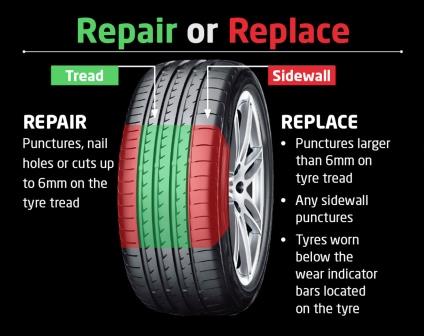No one wants to sit on the side of the road with a flat tire, but it happens. Because you want to get back on the road for as little money as possible, you might be evaluating your repair options. This might bring you to ask – can you patch a hole in the sidewall of a tire?
While a lot of tire punctures can be repaired, there are some that shouldn’t be attempted. In this guide, we talk about when you should and shouldn’t repair a tire. We also look at whether a patch is a better tire repair option than a plug.
Table of Contents
1
Can You Patch a Hole in the Sidewall of a Tire?No, if there is a leak or hole in the sidewall, you should not consider patching or plugging it. Sidewall repair should not be attempted because it can degrade the integrity of the tire, leaving you compromised on the road. Because the sidewall flexes, a repair is more likely to fail.
Your safety becomes more compromised when you start to travel at higher speeds or operate your vehicle at higher temperatures. The sidewall patch is susceptible to blowouts and leaks, which is why most reputable tire shops will not perform the repair.
The best solution to a damaged sidewall is always to replace the tire, even if it’s just a small nail. Yes, it will cost you more upfront, but what is the price that will be paid if you get into a deadly accident because of a tire blowout? There’s no comparison.
On the bright side, punctures to the sidewall are not nearly as common as tread damage, so it’s likely that your tire is repairable. If you are unsure whether a tire should be repaired or not, it’s best to have a professional tire shop take a look at it.
READ MORE: What is a Tire Sidewall Damage (& When to Replace the Tire?)
What is a Tire Patch?The tire patch is a piece of rubber that contains an adhesive backing. This adhesive side sticks to the inside of the tire, creating a seal around the puncture.
Tire puncture repair is also done with tire plugs. These plugs are a strip of material that gets coated with a rubber compound before it is put inside the hole. This plug will seal to the inside of the tire, stopping air from seeping out of the tire.
The tire patch is normally stronger and more reliable than the tire plug. However, it does take more work to apply a tire patch than it does a plug. Many tire shops use a hybridized tire plug and patch design that incorporates both for a better repair.
RELATED: Are Tire Plugs or Tire Patches Better?
What Causes a Hole in the Tire Sidewall?1. ImpactThe main reason for damage to the tire sidewall is because of impact. We’ve all been guilty of running into a curb or scraping against it, both of which can cause a puncture.
However, other impacts are to blame as well. Whether you hit a pothole too hard or a piece of debris flies up into the sidewall, all of these instances can lead to a puncture.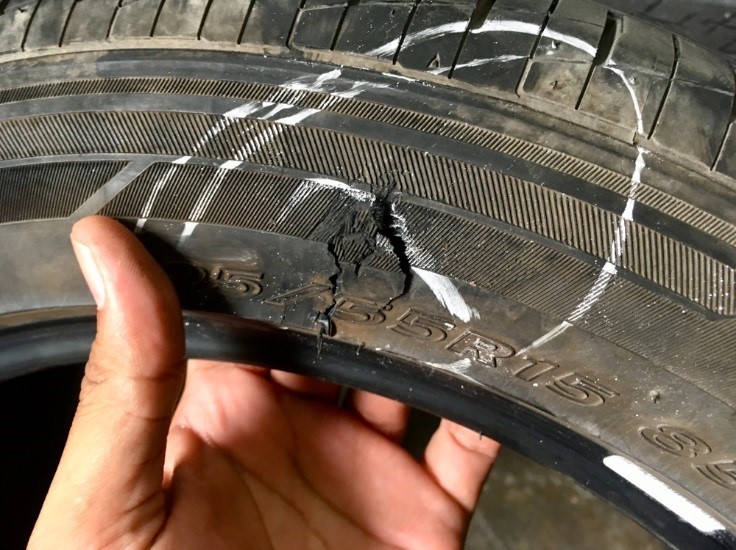 On top of that, you can end up with a punctured tire after a car accident, which is why you want to do an in-depth inspection of the vehicle after any impact.
On top of that, you can end up with a punctured tire after a car accident, which is why you want to do an in-depth inspection of the vehicle after any impact.
For the tire to hold the weight of your vehicle, it must be properly inflated. If the tire is underinflated, it won’t have the air pressure needed to hold the vehicle’s weight. However, the opposite is also a problem. When the tire pressure is too high, it puts an excessive amount of pressure on the sidewall, possibly causing a blowout or puncture because of the stress.
Find the appropriate psi for your car tires on the label inside the driver’s side door jamb. If you still aren’t sure, it’s best to ask for guidance from your local tire shop. Many of these locations will perform regular air pressure testing for free to regular customers.
RELATED: How to Find the Correct Tire Pressure For Your Car (4 Steps)
3. Old AgeTires that sit unused are susceptible to tire dry rot. This occurs even more frequently when the tires sit in the sunlight.
This occurs even more frequently when the tires sit in the sunlight.
Additionally, old age, in general, can cause a tire to degrade. If the tire has been around for more than ten years, it might be time to consider replacing them. Although, it’s best to start inspecting the tires more regularly once they reach five years old.
4. OverloadingYour car tires are only meant to have a certain amount of weight on them. You can find this information found in the owner’s manual or on the driver’s side door jamb.
If you exceed this weight, it can cause too much pressure on the tires. This added weight leads to a breakdown of the tire sidewall and tread, causing a puncture or blowout.
5. DefectsThere’s always the chance that the tires were put on the vehicle with manufacturer defects. While this isn’t common, it has happened.
To prevent this, you want to be careful what tires you install on your car. It’s tempting to put the cheapest tires possible on your car, especially when money is tight.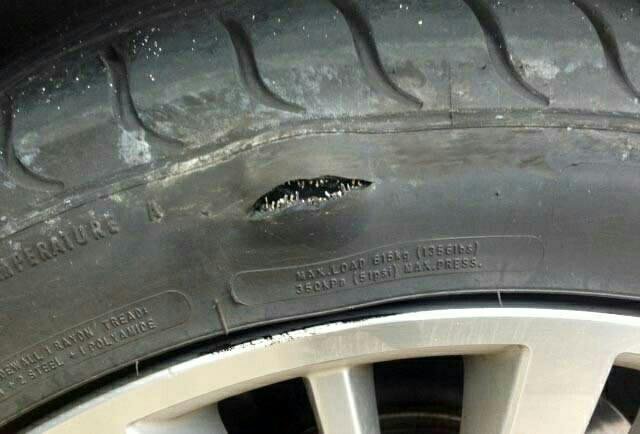 However, the savings will mean nothing if the tires fail you and cause an accident.
However, the savings will mean nothing if the tires fail you and cause an accident.
For a tire puncture to be repaired, it must meet certain criteria. While some people will attempt to repair punctures in other circumstances, it’s not always recommended. Reputable tire shops will only patch or plug a tire that matches these criteria:
If all of these requirements can’t be met, there should be no repair. Instead, a tire replacement would be the only safe option. Depending on the condition of your other tires, you might need to replace more than one to keep things uniform. However, if these requirements are met, you could repair it. Follow the advice of most professional tire shops and use a patch-plug kit for the best results.
However, if these requirements are met, you could repair it. Follow the advice of most professional tire shops and use a patch-plug kit for the best results.
If you use a tire plug, it might last seven to ten years when done properly and care is taken. It’s designed to last a minimum of 25,000 miles. However, for the plug to be successful there must be a proper seal between the material and the tire tread.
Patches could last a little longer and are generally seen as the more reliable option. It could last the life of the tire as long as the repair is performed properly. If you get the patch installed at a shady shop or it’s done in a place where it doesn’t belong, it could fail prematurely, leaving you with bigger troubles.
Ideally, you would combine the two for the best fix. Use a plug and patch for maximum protection.
RELATED: How Much Does It Cost To Get a Tire Patched?
One of the problems you can encounter when traveling by car is a punctured tire. Using a patch is a fairly common option to work around this issue.
Yet, if the hole is in a position like a tire wall, the problem becomes much more complicated because it is likely that the defensive position will not be patched.
So, how close to the sidewall can a tire be patched? A distance of 6 mm or more from the tire shoulder is required to fit a patch. In other words, if a crack is closer than 6mm, there’s almost nothing you can do about it!
Tire Sidewall OverviewFirst, let’s learn about sidewalls and how to identify them on your tires.
The wall is the rubber part from the outer edge of the rim to the road surface. This part also has the largest area, is the most flexible, and continuously deforms under loads when moving.
This part also has the largest area, is the most flexible, and continuously deforms under loads when moving.
As you know, the car’s wall is in a particular location, so it is pretty challenging to troubleshoot the hole here.
Manufacturers also recommend that you not choose the patch option if the spot is on the side of the vehicle or too close to this position. Then, how close to the sidewall can a tire be patched.
You cannot use the patch if the hole is close to the wheel with a gap of less than 6mm. In addition, you should note that if the hole is more significant than ¼ inch, the patch should not be used. In this case, if the patch is small, it cannot cover the hole, causing the wheel to deflate still when moving.
On the contrary, using a large patch can make the wheel more bulky, difficult to move, and unsafe.
Fix Sidewall DamageOther Related QuestionsTo better understand the problems that occur with the tires and how to overcome them effectively, you can refer to the following information.
We’ve put together some frequently asked questions that may help answer your questions on this topic.
Plug a flat tire: Is it possible?People are often concerned about whether it is safe to plug or patch a flat tire.
These two options are pretty standard in repairing or overcoming the problem of flat tires caused by rolling nails or other sharp objects.
The manufacturer still recommends that you better replace the tire with a new one when there is a problem because repairing with a plug or patch when a flat one is not a safe solution.
Yet, the cost of new tires is not cheap, and if you have this problem often, it is a big problem.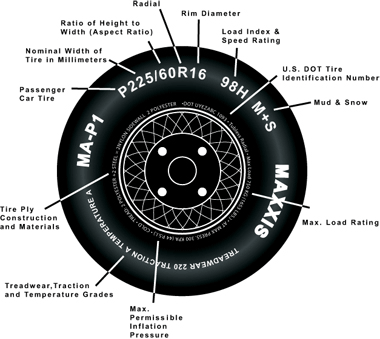 So, many drivers use a plug or patch when a wheel is punctured.
So, many drivers use a plug or patch when a wheel is punctured.
There is a limit to the number of nails or patches on a product. You can use this option to temporarily fix the problem if you find a few small holes. If the wheel has many large holes or previous patches, it is best to replace it with a new one.
For a detailed guide, check out this video:
How close can a tire patch be to another patch?The gap between patches is also a topic that people are very interested in. When traveling on the road, you may encounter a flat one many times.
As you know, when the tires have had previous patches or punctures in close locations, it is better to replace them. In case
In case
In the case of a puncture on the tire side, the use of stickers is unlikely to have as much effect as you think.
The reason is that its wall adhesion is so thin that relatively few materials can adhere. More specifically, damage to the sidewall will seriously damage the structure of a wheel.
The solution to this problem is to insert an extra tube inside the wheel to ensure that you can still turn the whole thing.
How fast can you drive on a patched tire?A patched one will not achieve the same speed and performance as it once was. Therefore, the optimal level you can expect from such a version will not be more than 85 mph. Of course, this is just the limit that many manufacturers recommend, but you should not overdo this limit.
Can you patch a tire with 2 nails in it?The answer is yes! It’s just that the gap between the two punctures is at least 16 inches, and you might seal them with two large patches.
According to many manufacturers, the maximum number of times performed is two times. If more than that, it’s time to get a new one.
ConclusionAs such, a puncture in the side of the vehicle is a unique location where patching is not an optimal solution in this case. It would help if you changed to a new tire to ensure safety when traveling.
Thank you for following this post!
This post was last updated onCategory: Operation and maintenance
Article reading time: 5 minutes
Bookmark this
A car tire has a complex structure and a specific rubber compound that protects the tire from impacts and retains its shape under high loads. The design of the wheel consists of several strength frames - metal wire and nylon thread, they keep the rubber on the trajectory during intense and dangerous driving.
The design of the wheel consists of several strength frames - metal wire and nylon thread, they keep the rubber on the trajectory during intense and dangerous driving.
Any kind of damage can result in negative consequences that will affect driving safety and stability on the road. And if the majority of punctures can be repaired in the service or repaired by oneself, then the side cut of the tire often forces one to resort to a complete tire replacement. Riding on damaged tires in the usual mode is extremely dangerous. How to fix a tire so that you can ride comfortably without consequences, and is it possible to seal or repair a cut tire? We will answer these and other relevant questions for motorists in this material.
Modern services can repair a tire after a front or side puncture. You can repair a tire, thanks to the universal set of a motorist, with your own hands. It is enough to seal the hole with a special tourniquet.
Is this type of damage dangerous and should it be replaced? Only the master can unambiguously answer the question, having studied the lateral damage. The specialist will determine the nature of the puncture that needs to be repaired and offer a complete tire replacement or repair. It is inexpedient and dangerous to close up a large puncture, due to which the tire is deformed.
To determine how to close a side cut, you need to study the type of damage:
Sealing a cut on a tire is much more difficult than a normal repair, so it is often necessary to perform an involuntary replacement of tires. Repairing the wheel is impossible due to side wires and threads that break under side load. Taping and repairing lateral damage will not help repair the threads. Any obstacle or potential contact with a bump at high speed will have the adverse effect of bursting the tire due to the load, resulting in a dangerous loss of control.
Taping and repairing lateral damage will not help repair the threads. Any obstacle or potential contact with a bump at high speed will have the adverse effect of bursting the tire due to the load, resulting in a dangerous loss of control.
A side puncture is less dangerous than a longitudinal cut. However, not every defect requires replacement. Masters will be able to repair tires if the deformed area placed along the carcass threads does not exceed 50 mm. The possibility of repair is also available if the side cut located across the tire threads is less than 30 mm. However, we do not recommend doing repairs in this case with your own hands. To preserve the protective properties and avoid possible negative consequences, it is necessary to use professional equipment.
Should cuts be repaired? A popular question for motorists who are faced with a choice is whether to seal a defect or replace a wheel. The possible consequences of cuts scare car owners, but do-it-yourself repairs are more attractive because they are cheaper than buying fresh tires.
To avoid dangerous consequences, sealing small and large side cuts is prohibited if more than 10 cords are to be repaired and a hole larger than 30 mm is to be patched. It is possible to repair tires for passenger cars with a side cut of the tire if it is a shallow scratch.
Driving with a cut in a tire is not safe. The degree of risk depends on the nature of the damage and the experience of the specialist who will seal the seam. Before sealing the hole with your own hands or entrusting a restoration to a specialist, you should examine the lateral damage. Manufacturers recommend replacing tires if it is necessary to seal 20 mm or more. However, if it is possible to change a wheel, the opportunity should be taken as soon as possible. Since even a small defect is dangerous during the trip. During operation, a hernia is formed, which explodes if timely replacement is not made. If you drive on a tire with a side cut for a long time and do not do repairs in the service or with your own hands, there is a high risk of getting into an accident.
In order to strengthen the structure of tires, manufacturers add several layers of metal cord to models. Also on the market there is a fabric cord, which includes fibers from nylon, which allows you to increase the strength of rubber. Therefore, in order to seal the tire in the service or repair it yourself in case of a puncture, it is necessary to use high-quality materials. If the recommendations for replacement are not followed, there is a high risk of dangerous and unpredictable consequences.
Winter Drive protection
Tires Goodyear UltraGrip Arctic 2 SUV
Winter Drive Protection Sound Comfort
Rating:
4.5
Tires Goodyear UltraGrip Ice 2
Winter Drive protection
Tires Goodyear UltraGrip Performance+ SUV
Winter Drive protection
Tires Goodyear UltraGrip Arctic 2
Winter Drive Protection Run On Flat Sound Comfort
Tires Goodyear UltraGrip Performance+
To accurately assess the effects of tire deformation, before repairing a tire, contact a specialized center.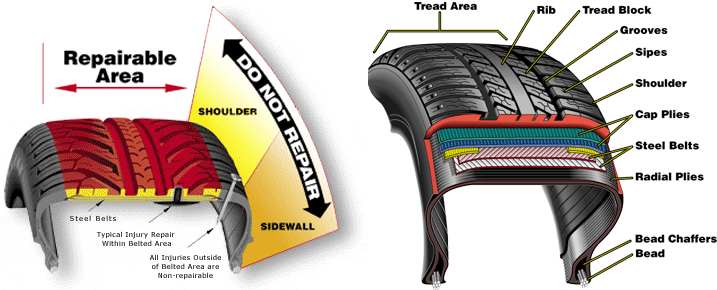 The masters will figure out whether it is possible to continue driving a car or whether it is worth replacing the rubber. The main inspection criterion is the width of the seam that needs to be repaired. It should be borne in mind that it is dangerous to close up and seal holes with a width of more than 40 mm with rubber mixtures.
The masters will figure out whether it is possible to continue driving a car or whether it is worth replacing the rubber. The main inspection criterion is the width of the seam that needs to be repaired. It should be borne in mind that it is dangerous to close up and seal holes with a width of more than 40 mm with rubber mixtures.
If the craftsmen decide to restore the tire and make a patch, then the restoration process includes the following steps:

The decision to patch should be made by experienced professionals who will be able to advise whether to patch or replace tires. Restoration of rubber, despite the observance of technology, cannot restore the original properties of the carcass, so you should drive carefully on such rubber.
It is also worth considering that if you do the restoration of a tire, it is necessary to break in before active operation. To avoid negative consequences, we do not recommend moving at high speeds.
Author of the article: Goodyear team
KrasnodarArmavirGelendzhikTuapseSochiNovorossiyskBelorechenskMaikopRostov-on-DonSimferopolStavropolAstrakhanst. Kanevskaya station Vyselkist Dinskaya Volgograd Voronezh
TSC No. 13 pos. Verkhnebakansky, st. Bakanskaya, 8A
+7 (928) 331-07-76
Around the clock
TSC No. 29, Volgograd, 30th Anniversary of Victory Blvd., 9
29, Volgograd, 30th Anniversary of Victory Blvd., 9
+7 (937) 088-44-27
Mon-Fri from 09.00 to 20.00, Sat from 9.00 to 19.00, Sun from 10.00 to 18.00
TSC No. 28, Rostov-on-Don, st. Dovatora, 159
+ 7 (988) 997-61-11
Mon-Fri from 09.00 to 20.00, Sat from 9.00 to 19.00, Sun from 10.00 to 18.00
TSC No. 18, Krasnodar, Berezovy village, Karl Gusnik st., 17
+ 7 (938) 538-53-11
Mon-Fri 9:00 - 20:00; Sat 9:00 - 19:00; Sun 10:00 - 18:00
TSC No. 27, Sochi, Batumi Highway 94/20
+7 (928) 272-72-55
Mon-Fri from 09.00 to 20.00, Sat from 9.00 to 19.00, Sun from 10.00 to 18.00
TSC-26 Voronezh, st. Volgogradskaya 30
+7 (930) 406-78-84
Mon-Fri from 9. 00 to 18.00
00 to 18.00
TSC No. 25, Volgograd, Bureyskaya st., 8
8 (937) 088-42-78
Mon-Fri from 9.00 to 18.00
TSC No. 22, Stavropol, ave. Kulakova, 18
+7 (938) 517-77-03
Mon-Fri from 9.00 to 18.00
TSC №21 Armavir, Efremova 319
+7 (918) 322-76-38
Mon-Fri from 09.00 to 20.00, Sat from 9.00 to 19.00, Sun from 10.00 to 18.00
TSC No. 19, Krasnodar, st. Selezneva 197/5
+7 (989) 169-34-16
Mon-Fri 9:00 - 20:00; Sat 9:00 - 19:00; Sun 10:00 - 18:00
TSC No. 17 Astrakhan, 1st passage Rozhdestvensky 11a
+7 (988) 172-66-88
Mon-Fri from 9.00 to 18.00 Sat-Sun day off
TSC No. 16, Rostov-on-Don, st. Dovatora, 154/5
Dovatora, 154/5
+7 (989) 527-11-86
Mon-Fri from 9.00 to 18.00 Sat-Sun day off
TSC No. 15 st. Vyselki st. Luneva, 29a
+7 (918) 199-67-89
Mon-Fri from 9.00 to 18.00, Sat from 10.00 to 15.00, Sun from 10.00 to 15.00
TSC No. 14 Crimea, Simferopol, 11 km. Moscow highway
+7 (938) 517-77-82
Mon-Fri from 9.00 to 18.00 Sat, from 10.00 to 15.00, Sun closed
TSC No. 12, Gelendzhik, st. Lunacharskogo, 310A
+7 (918) 027-88-99
Mon-Fri from 09.00 to 20.00, Sat from 9.00 to 19.00, Sun from 10.00 to 18.00
TSC No. 11 st. Kanevskaya, st. Sverdlikova, 277d
+7 (988) 312-97-70
Mon-Fri from 09.00 to 20.00, Sat from 9.00 to 19.00, Sun from 10. 00 to 18.00
00 to 18.00
TSC No. 10, Krasnodar, st. Russian, 339
+7 (989) 298-90-17
Mon-Fri 9:00 - 20:00; Sat 9:00 - 19:00; Sun 10:00 - 18:00
TSC No. 9, Tuapse, p. Kroyanskoe, st. Solnechnaya, 1B
+7 (918) 060-47-17
Mon-Fri 9:00 - 20:00; Sat 9:00 - 19:00; Sun 10:00 - 18:00
TSC No. 8, Krasnodar, st. Stavropolskaya, 214/5
+7 (918) 060-47-08
Mon-Fri 9:00 - 20:00; Sat 9:00 - 19:00; Sun 10:00 - 18:00
TSC No. 7, Krasnodar, st. Dinskaya, Federal highway M4 1308 km, 3
+7 (918) 060-47-07
Around the clock
TSC No. 6, Belorechensk, st. May Day, 122
+7 (988) 369-96-37
Mon-Fri from 09.00 to 20.00, Sat from 9.00 to 19.